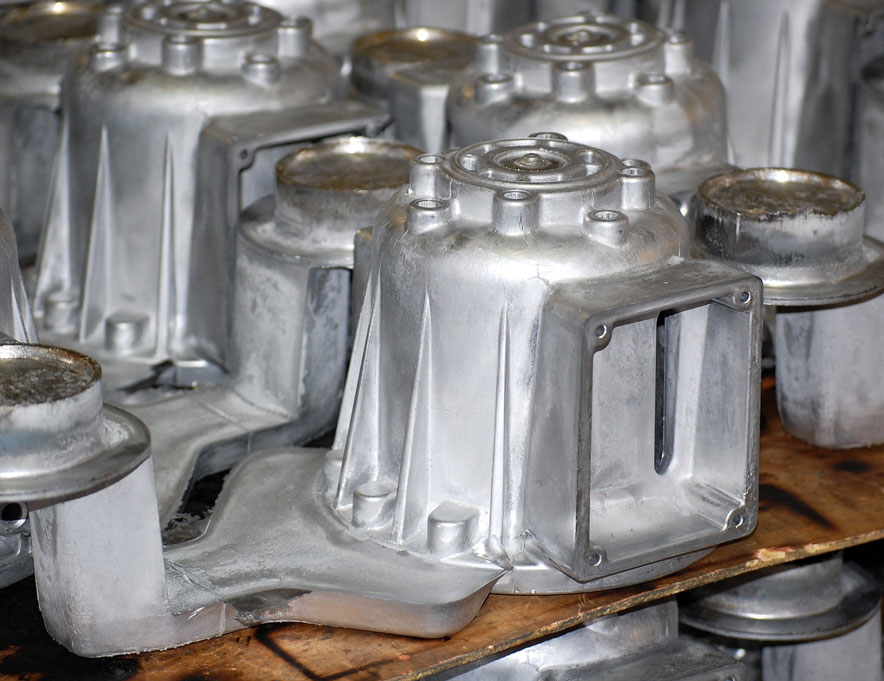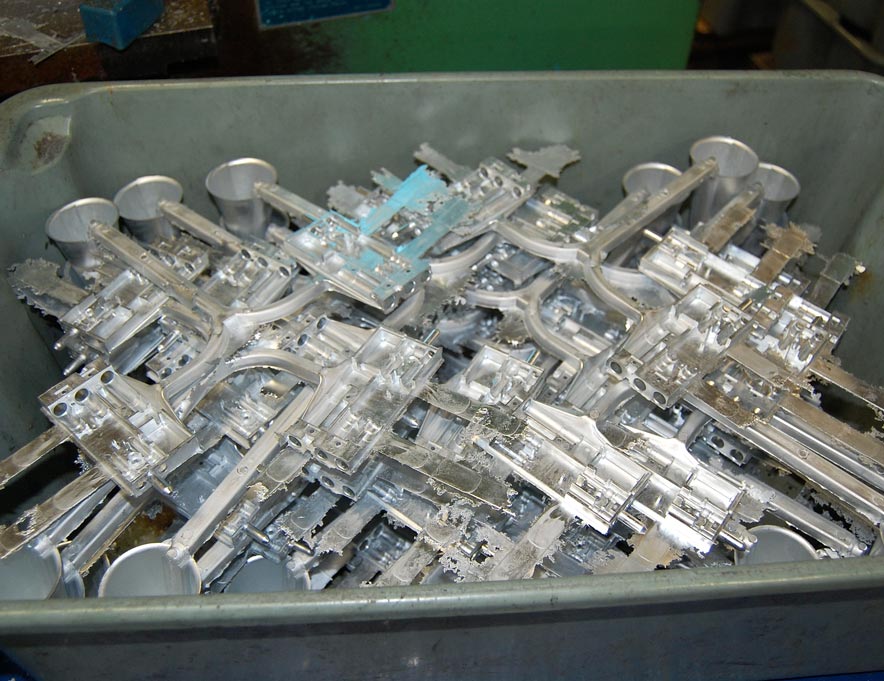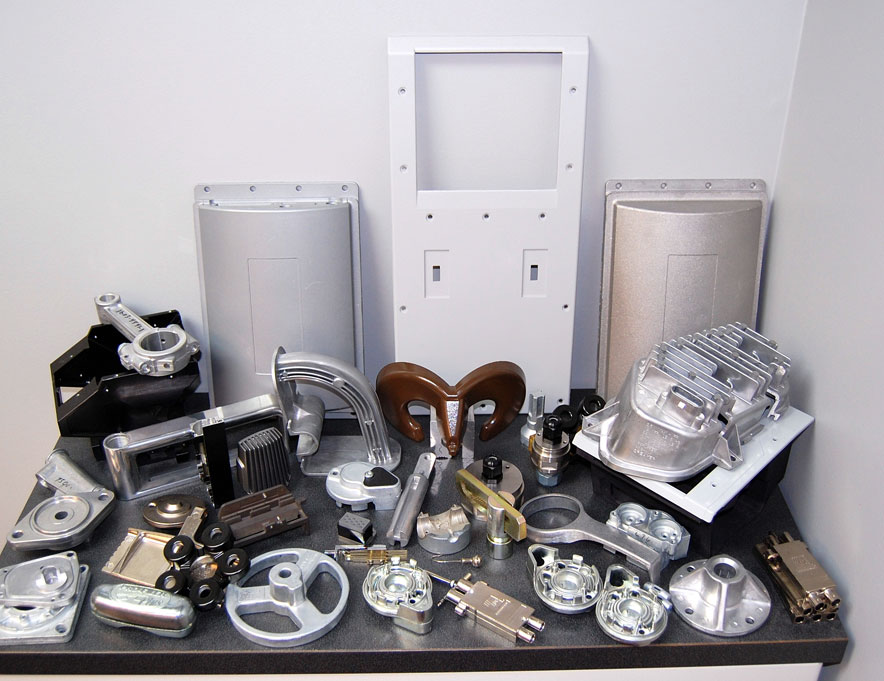There are two primary methods of die casting: cold chamber die casting and hot chamber die casting.
At DyCast Specialties, we are an industry leading supplier of high-quality aluminum and zinc die castings. Our full service capabilities enable us to serve as a single source for all die casting project needs, from initial design to casting to precision machining to finishing and assembly. All of our castings are custom formed, trimmed, machined, and finished to the customer’s exact specifications and standards, ensuring they perform as intended in the application environment.
Below, we provide an overview of the die casting process, including what it entails, the types of casting methods available, key advantages over other manufacturing methods, common materials used in die casting operations, and typical applications of die cast parts and products.
What Is Die Casting?
Die casting is a metal forming process that involves heating, melting, and pressurizing the metal, injecting the molten metal under high pressure into a custom made die, and allowing it to cool and harden into the desired shape.
While the steps in a die casting process may vary slightly from project to project depending on the part and production specifications, they generally include the following:
Types of Die Casting
Cold Chamber
In cold chamber die casting, the casting metal is heated and melted in an external furnace. The molten material is then manually or automatically transferred to the injection system, which, in turn, transfers the metal to the casting die. The advantage of this method over hot chamber die casting is its ability to accommodate a broader range of metals. Some metals have higher melting points than are practically achieved with integrated hot chambers. The external furnace component in cold chamber die casting equipment easily reaches the temperatures necessary for these metal. However, the additional step of moving the molten metal from the furnace to the injection system increases the overall production time and, consequently, the production costs.
Hot Chamber
In hot chamber die casting, the casting metal is heated and melted in a furnace integrated with the injection system. The chamber of the injection system is immersed in the molten metal, enabling it to draw and inject material into the cavity quickly and easily. As this method does not require the transference of molten metal between the furnace and injection system, it is faster than the cold chamber die casting process. However, since the hot chamber integrated furnace cannot achieve temperatures as high as the cold chamber external furnace, it is best suited for casting metals with lower melting temperatures, such as zinc.
Advantages of Die Casting
Compared to other manufacturing methods (including other casting methods), die casting offers a number of advantages, such as:
Greater strength with lower weight. Since die castings are not welded, fastened, or otherwise joined together, the maximum strength of the component is that of the base material rather than of the joint. Additionally, they exhibit greater strength than plastic injection molded components of the same shape and size and accommodate thinner walls than cast components made through other methods.
Higher accuracy. The die casting process creates parts and products that are dimensionally stable, meaning they are less likely to shrink or otherwise distort during the cooling and hardening stage. This quality makes it an ideal method for producing identical pieces with complex shapes to tight tolerances.
Faster production speeds. In die casting operations, a single die can impart all of the necessary design elements to the casting material in a single process. Additionally, the cast part produced generally requires little to no machining. As a result, manufacturers can produce large quantities of parts in shorter periods than is possible using other manufacturing methods.
Lower material cost and waste. Compared to subtractive manufacturing methods, die casting requires much less material and generates much less material waste.
Simpler assembly requirements. Die castings can be integrated with fastening elements (e.g., holes and threads) to facilitate final assembly operations.
Common Die Casting Alloys
The die casting process accommodates a wide range of materials, each of which offers unique characteristics that make it suitable for different cast parts and products. At DyCast Specialties, we utilize aluminum and zinc in our casting operations. Both of these metals and their alloys exhibit physical, mechanical, thermal, and chemical properties that make them ideal for use in castings.
-
Aluminum
Aluminum is a strong but lightweight material that exhibits excellent thermal resistance and corrosion resistance, great thermal and electrical conductivity, and good finishing properties. However, as it is susceptible to cracking and shrinking in high temperatures, it is typically alloyed with copper or silicon to increase its hardness and fluidity. These characteristics, among others, make it an ideal material for die casting operations. Manufacturers can use it to produce stronger and lighter components that withstand use in demanding conditions (e.g., exposure to high operating temperatures or corrosive compounds). They can also use it to produce components with complex shapes and thin walls as it has exceptional dimensional stability.
The DyCast Specialties team works with the following aluminum alloys:
- 380
- 383
- 413
-
Zinc
Zinc is a strong and hard material that demonstrates excellent corrosion resistance and electrical conductivity, great thermal conductivity and dimensional stability, and good thin wall and cold forming ability. These qualities, among others, makes it ideal for use in die casting operations. Manufacturers can use it to produce complex net-shape components with strong and sturdy thin walls.
The DyCast Specialties team works with the following zinc alloys:
- Zamak #3
- Zamak #5
- Zamak #7
-
Zinc-Aluminum
Zinc-aluminum alloys combine the properties of zinc and aluminum, resulting in materials that are lightweight along with excellent strength, hardness, and bearing properties. The mechanical properties vary slightly from alloy to alloy depending on the exact composition.
The DyCast Specialties team works with the following zinc-aluminum alloys:
- ZA-8
- ZA-27
Quality Die Castings from DyCast Specialties
If you’re looking for quality die castings, turn to the experts at DyCast Specialties. By partnering with us, you benefit from our:
Full-service die casting capabilities. We are a one-stop source for all aluminum and zinc casting needs. Our experts guide customers from initial design to casting to finishing to final assembly, ensuring they receive a cast component that fully meets their needs.
Highly responsive/flexible team members. Our team is trained to react and respond quickly to customers, answering and addressing any questions or issues that may arise during the project. As the business changes, they adapt to meet shifting customer needs.
Highly responsive/flexible team members. Our team is trained to react and respond quickly to customers, answering and addressing any questions or issues that may arise during the project. As the business changes, they adapt to meet shifting customer needs.
Pull replenishment systems. We offer Kanban programs to customers with high-volume contracts to help optimize their product inventories.



